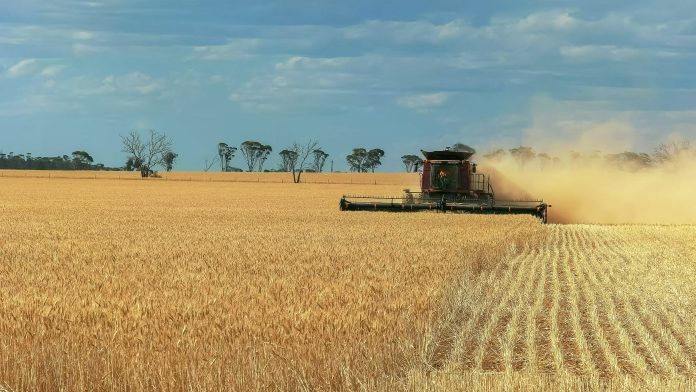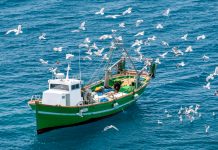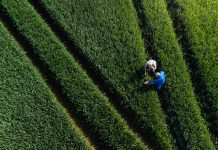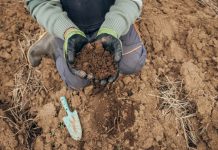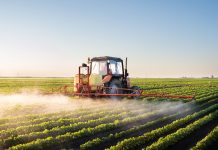Dr Stephen Davies, Principal Soils Research Scientist provides expertise in managing soil limitations in cropping systems with a focus on developing practical solutions for grain growers
Dryland grain production in Western Australia (WA) relies on winter dominant rainfall that, over the past few decades, has been declining with a 14-20% reduction in growing season rainfall across the cropping region. The soils used for grain growing are typically ancient, sandy, and infertile, with a limited capacity to store water and nutrients.
Grain production in Western Australia
The grains industry in Western Australia (WA) typically produces about 18 million tonnes yearly, with 80-90% of this exported, primarily to Asia and the Middle East. This represents nearly 40% of Australia’s winter crop production. Grains are the biggest contributor to the gross value of agricultural output in WA, which in 2021-22 was estimated to be $10.7 billion AUD. Wheat is the biggest crop grown in WA, accounting for 48% of the gross production value, followed by oilseeds at 25% and barley at 18%, with smaller contributions from oat and pulse crops. The grain growing area is in the south-west corner of the state with a total arable land area of 15.7 million hectares, with about 75% of this cropped annually.
Ancient infertile soils
The dominant soil types used for grain cropping in WA are deep sands, deep sandy earths, ironstone gravels, and texture contrast soils with sandy A horizons, which combined make up nearly two-thirds of the area cropped. The soils are typically inherently infertile with low organic matter content despite long-term adoption of minimum tillage and stubble retention by most grain growers. The capacity of WA’s soils to store organic matter is limited by net primary productivity due to low rainfall and surface soils with low clay content, typically less than 5% clay.
These soils typically have multiple physical and chemical soil constraints, which restrict crop growth and productivity. These include topsoil water repellence and subsurface acidity, subsurface hard pans (layers) and on the texture contrast soils clay B horizons that can often be saline, dispersive (structurally unstable due to high soil sodium) and have high alkalinity. Soil acidification is induced by agriculture, but in WA, it can also be an inherent property of some deep sandy earths.
Soil acidification results in aluminium toxicity, which acts like a chemical hardpan preventing root growth into the soil profile. Subsoil acidity affects approximately 70% of agricultural soils, with an indicative cost in lost grain production of about $1.5 billion AUD annually. Hardpans can also form because of natural cementation processes or from machinery induced compaction, or a combination of both. These physically dense hardpans slow and prevent root growth into the subsoil, restricting access to water and nutrients.
Subsurface hardpans are estimated to impact 75% of agricultural soils in WA and cost $0.9 billion AUD in lost production annually. Topsoil water repellence is a consequence of low clay content in the topsoil making them susceptible to being readily coated in hydrophobic organic particulate compounds of both plant and microbial origin. Topsoil water repellence results in uneven soil wetting, increased surface runoff, poor and staggered crop establishment, and poor weed control.
Research to overcome soil constraints in WA’s cropping systems
The Department of Primary Industries and Regional Development (DPIRD) in Western Australia has undertaken soil research and development in WA for three decades to overcome soil constraints that limit grain production. The research has mainly been done on commercial farms in close collaboration with growers and industry, leading to widespread adoption of the research findings.
Department researchers have long promoted and demonstrated the use of lime to prevent and correct soil acidity. WA has large deposits of high-quality coastal lime sands, particularly in the northern half of the grain-growing region, that are cheap relative to other sources and highly effective.
These deposits are ancient, formed from tiny seashells blown into large dunes and are suitable for spreading without additional crushing. These calcium carbonate deposits are often quite pure, with neutralising values of 90% or more.
Crushed limestones and dolomites are also available but are used in areas distant from coastal lime sources and are more expensive due to the need for more processing. Through continuous research, development and extension efforts, the use of liming products on soils in WA has significantly increased. However, it is estimated that the application rate is currently only 50% of what is necessary to address existing soil acidity and prevent further acidification.
In WA’s dry, rainfed cropping systems, it has also been found that surface spread lime can take many decades to neutralise the acidity in deeper subsurface layers. This has driven a need to mechanically incorporate lime with strategic, one-off, deep tillage. This is often achieved using deep soil mixing implements such as rotary spaders, inversion ploughs and large deep-working offset discs.
Deep mixing and inversion also buries topsoil, reduces topsoil water repellence – improving soil wettability and crop establishment – and loosens the soil to the working depth of the implement.
Deep ripping, or subsoiling, is practised by nearly 40% of WA grain growers annually. It is usually applied to part of their cropping program and loosens subsoils and removes hardpans. The depth of deep ripping was traditionally 30-40cm, but research over the last decade has shown that ripping to 50cm deep or more is now required, given the increase in the size of farm machinery and the strength and depth of compacted hard pans.
While these occasional deep tillage practices combined with liming where required are expensive to implement, they typically increase crop yields by 40% or more with lasting improvements in crop productivity, water use efficiency, and profitability.
Future research: soil management
Future research will focus on soil management to further improve soil resilience, crop water use efficiency and nutrient use efficiency, while maintaining a sustainable and resilient soil resource base in the face of increasing heat and drought stress.
Combining novel and lasting soil management practices with improved crop genetics for adaptation to climatic and edaphic constraints, along with efficient and accurate agronomic practices, will ensure a successful and profitable grains industry can be maintained in WA.
Contributor Details
Editor's Recommended Articles
-
Must Read >> 21st Century agriculture
-
Must Read >> 21st Century agriculture


